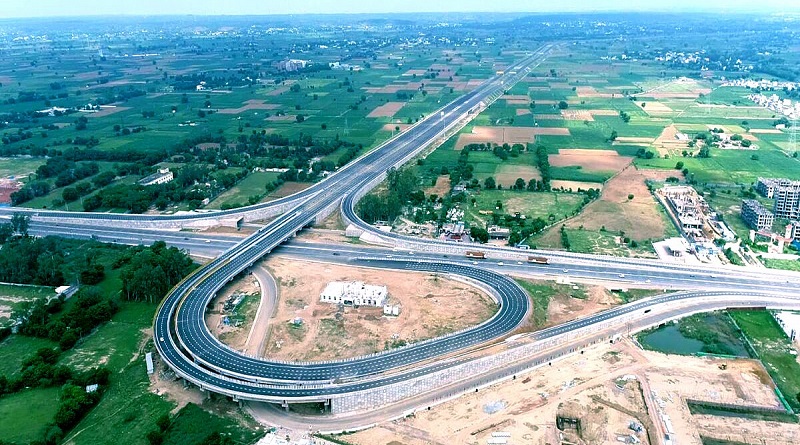India’s Expanding Road Network: Driving Economic Growth and Connectivity

India ranks second among the countries with the largest road network in the world, which is a symbol of its economic and social progress. This extensive network not only connects different parts of the country, but also promotes national and international trade, tourism and social inclusion.
Top 5 Largest Road Networks in the World (2024):
- United States – 6,586,610 kilometers
- India – 6,371,847 kilometers
- China – 5,200,000 kilometers
- Brazil – 2,000,000 kilometers
- Russia – 1,283,387 kilometers
🇮🇳 India’s Road Network: Expansion and Development
India’s road network spans over 6.37 million kilometers, making it the second-largest in the world. It comprises national highways, state highways, rural roads, and urban roads.
Major Highways and Projects
- National Highway 44 (NH-44): This is the longest highway in India, stretching approximately 3,745 kilometers from Srinagar to Kanyakumari.
- Delhi-Mumbai Expressway: This expressway is about 1,200 kilometers long and will reduce travel time between Delhi and Mumbai by up to 12 hours.
- Golden Quadrilateral Project: A key road initiative connecting the four major metropolises—Delhi, Mumbai, Chennai, and Kolkata.
- Bharatmala Project: An ambitious plan aimed at integrating India’s border and backward regions into the mainstream through improved connectivity.
Recent Developments
In the past decade, India’s national highway network has grown by 60%, from 91,287 km in 2014 to 146,195 km in 2024. Furthermore, the length of highways with four or more lanes has increased by 2.6 times, and the speed of construction has risen 2.8 times.
Social and Economic Importance of India’s Road Network
- Freight and Passenger Transport: Roads in India handle around 71% of freight and 85% of passenger transportation.
- Road Density: India’s road density is 1.94 kilometers per square kilometer, significantly higher than that of the USA (0.71 km), China (0.54 km), Brazil (0.23 km), and Russia (0.09 km).
- Rural and Urban Connectivity: Under key initiatives such as the Pradhan Mantri Gram Sadak Yojana (PMGSY), road connectivity in rural areas has improved substantially, promoting both social and economic development.
Future Plans and Challenges
Upcoming Projects
- Widening of Two-Lane Highways: The government plans to upgrade 25,000 to 30,000 kilometers of two-lane highways to four lanes, with an investment of approximately ₹10 lakh crore.
Union Minister Nitin Gadkari has announced an ambitious infrastructure initiative to upgrade approximately 25,000 to 30,000 kilometers of existing two-lane highways to four lanes across India. This project, with an estimated investment of ₹10 lakh crore, aims to enhance the nation’s economic strength through improved connectivity and transportation efficiency.
The Ministry of Road Transport and Highways (MoRTH) plans to implement this massive expansion by encouraging the Infrastructure Investment Trust (InvIT) model to raise funds from Indian investors. This approach is expected to facilitate the mobilization of substantial capital for the project.
Major Challenges
- Environmental Impact: Land acquisition and environmental clearances often delay major road projects.
- Maintenance and Quality: There is a need to improve the quality and upkeep of roads, especially in rural and remote areas.
- Financing and Private Participation: Ensuring adequate financing and promoting private sector participation is essential for the success of large-scale projects.
Conclusion
India’s road network is not only vast in size but also forms the foundation of the country’s economic, social, and cultural progress. The government’s policies and projects are working towards making this network more robust and comprehensive. However, it is essential to address environmental, financial, and managerial challenges so that the road network can truly become a means of sustainable development and inclusive growth.
The government has launched several ambitious initiatives for national highway development, such as the ‘Bharatmala Project’ and the ‘National Highway Development Project’. These aim to connect different parts of the country through high-quality roads, enhancing trade, tourism, and access to emergency services. Additionally, the Pradhan Mantri Gram Sadak Yojana has improved road connectivity in rural areas, helping strengthen the rural economy.
However, for the successful implementation of these projects, it is crucial to ensure adequate financing, transparency, and timeliness. Furthermore, following sustainable development principles is essential to maintain environmental balance.





Understanding gambling psychology helps recognize how platforms like JLJLPH Login use immersive experiences to engage players. It’s essential to play responsibly while enjoying slots, live dealers, and fishing games.